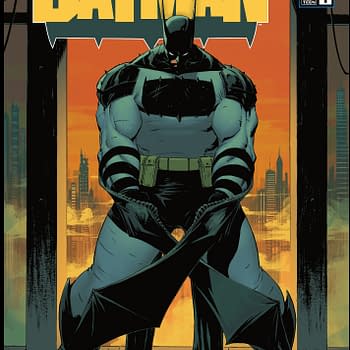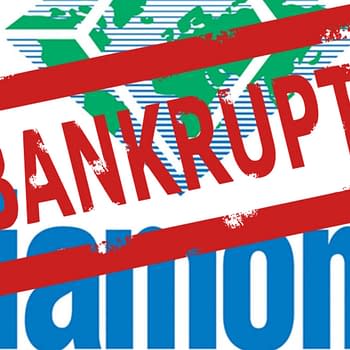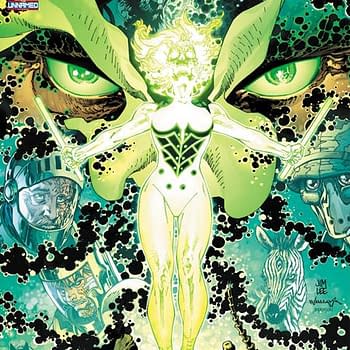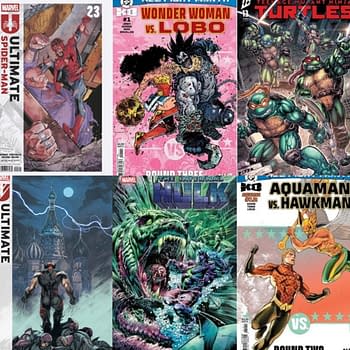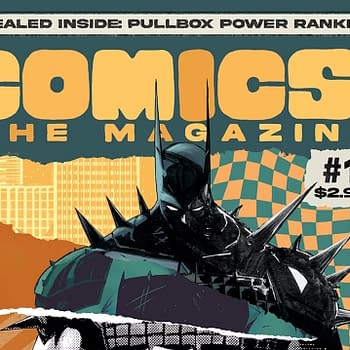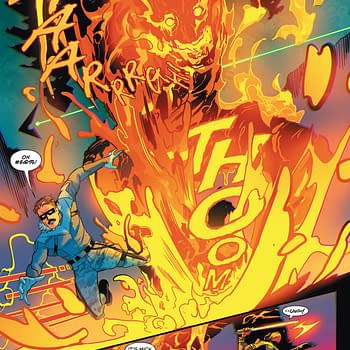Posted in: Comics | Tagged: Comics, dc, jla, justice league, steampunk
Look! It Moves! by Adi Tantimedh #119: How I Wrote The Steampunk Justice League

So in the spirit of shameless self-promotion, I thought I'd talk about my experience writing the book. After all, what's the point of having a weekly column if one doesn't do some shameless self-promotion from time to time? It might also be interesting for people to read about how a comic like this is created from the ground up.
It began back around 1999 when I was getting a bit tired of the movie stuff I was having to write and decided to contact Andy Helfer at DC to see if he might be interested in hearing some pitches. Andy had a reputation for being an editor who discovered a lot of new talent – he initialised the 90s run of JUSTICE LEAGUE that gave artists like Kevin Maguire and Adam Hughes their first successful assignments as artists, and was open to more quirky and experimental ideas. He was also a brilliant writer in his own right, and I was a big fan of his run on THE SHADOW where he turned the series into a very funny, subversive New York dark comedy and also put helped Kyle Baker on the map.
Andy was in charge of the Elseworlds books, and I initially pitched a Russian Superman Elseworlds that was a book-within-a-book, inspired by Norman Spinrad's THE IRON DREAM, which was an alternate history tale where Hitler didn't become leader of Germany but ended up a struggling pulp writer in America and the book itself was one of his novels, full of his obsessions and subtexts. This Elseworlds would be a self-contained issue of a Russian Superman comic where he would be dealing with post-Perestroika Russia after having been a Cold War icon, and the writer of the story was a young upstart writer who's something like the Russian counterpart of Warren Ellis commenting on the state of his country through a comic he was writing. Andy liked the pitch, but found that Mark Millar's RED SON was already in development, so did I have any other ideas. I proposed an alternative: "What if SUPERMAN had been written by H.G. Wells back in the late 1800s?"
Andy liked the idea and suggested we made it a JLA book since at that time, Grant Morrison's JLA and any auxillary books featuring the JLA were selling well. I agreed, as it would give us more characters to play with, run through the filter of H.G. Wells, Jules Verne and Scientific Romance. I suggested P. Craig Russell as the artist for creating that romantic fin-de-siecle look, and Craig suggested he drew the breakdowns while Galen Showman, his collaborator and studio-mate, handled full pencils and inks.
Gradually, it dawned on us that this story was so damn big and sprawling that it became a struggle to get its unwieldy mass into a manageable 96 pages when most people could have written big prose novels of over 800 pages to tell a story like this. Of course, it would have been dead easy if it was just about superheroes punching bad guys but that wasn't what we wanted to do. The types of things Andy and I were interested in showing the comic, the politics of an industrial revolution, the political and social consequences of rapid technological change, how the world starts to look when new architecture pops up and new technology becomes commonplace, how people react and live under them – this story was threatening to be as large and sprawling as WATCHMEN, except we didn't have 300 pages, we only had 96. Some days, trying to nail the plot down to manageable levels was a bit like staring at the abyss and the abyss was laughing and giving us the finger.
I always wanted to write a research-intensive period piece at some time or other, maybe end up on some BBC project eventually, not a DC superhero comic, and I probably bit off far more than I could chew with it being my first mainstream comics work. If it had been a 22-page monthly superhero book set in the present, it would have been easy enough to plot out and script. However, since I have a tendency to not choose the easy way to do things, I instead had two 48-page books to write. 48 pages can be a strange length since on first glance it looks like there's lots of room to tell the story, but considering this was a historical epic that was going to span decades, beginning in 1876 and going all the way up to 1914, the number of pages gets lower and lower the more story we found we needed to tell. We ended up taking about three years to finish the project, half of that spent writing it, the other half for the art to be completed. I even managed to start and finish two feature-length screenplays during that time.

It wasn't all hard work when I went into Andy's office. There are still memories unique to the job I carry with me, like when Andy showed me the original typed pages of Alan Moore's treatment for TWILIGHT OF THE SUPERHEROES that was kept on file there, or watching Andy review the artist's submissions that came in on an almost-daily basis, or when Kyle Baker would drop in during Andy's cigarette breaks, or his sadness upon hearing that his friend the artist and editor Joe Orlando died of a heart attack while heading home at Grand Central Station. Or when Andy had Kevin Maguire come in to sit in the corner to finish some pencils for another Elseworlds book JLA: CREATED EQUAL while we continued to hash out the plot of AGE OF WONDER and Andy chuckling over the fact that the whole premise of CREATED EQUAL was about Superman's sperm. Or hearing of Gil Kane's passing and attending the memorial service. Or seeing Andy get assigned to edit yet another series of DOOM PATROL and hearing him pitch it as a superhero team that tackled the really dirty, horrible stuff, only for it to be a comedy book by the time it came out, written by John Arcudi and drawn by Andy's latest discovery Tan Eng Huat. Interesting times.
Next week, I'll be doing a spoiler-filled annotation of the story, going over how we decided on what was depicted in the story and what we had to cut out, what we almost did and ended up not doing. So people can at least read the book and know what the hell I'll be talking about.
DC COMICS PRESENTS – JLA: AGE OF WONDER is out in comic shops this week.
Pretending to live in the past at lookitmoves@gmail.com
Follow the official LOOK! IT MOVES! twitter feed at http://twitter.com/lookitmoves for thoughts and snark on media and pop culture, stuff for future columns and stuff I may never spend a whole column writing about.
Look! It Moves! © Adisakdi Tantimedh






